Center of the American Experiment Testifies on the Minnesota Senate’s Clean Energy First Bill in Rochester
Last night, I drove down to Rochester to testify at a hearing on the Minnesota Senate’s Clean Energy First bill. As you will see in my testimony, this proposed legislation offers several significant improvements over previous legislation introduced to shape Minnesota’s energy future, such as those proposed last session by Governor Walz and the Minnesota House of Representatives. However, there are still a few problematic parts of this legislation that I address later on in my comments.
My testimony begins at 1:31:29 and I’ve pasted my comments below with additional links to provide references for my testimony.
https://www.facebook.com/mnsrc/videos/477619166520895/

January 15, 2020
Testimony Clean Energy First
Isaac Orr
Policy Fellow
Hello. My name is Isaac Orr, and I am a policy fellow specializing in energy and environmental policy at Center of the American Experiment. I would like to thank the committee for the opportunity to testify today on the Senate’s Clean Energy First bill.
This bill represents a tremendous improvement over previous legislation offered to shape Minnesota’s energy future, and the Committee is to be commended for adding several common-sense provisions to the bill.
Among the most important improvements in this legislation is the language allowing large hydro to satisfy “carbon free” requirements. Minnesota already imports approximately 11.7 percent its electricity from Manitoba hydro. Allowing this energy to qualify as renewable under the current renewable energy standard would further improve this legislation and allow Minnesota to meet its 2025 goals more cost effectively.
Another important feature is the provision legalizing new nuclear power plants in Minnesota. Center of the American Experiment’s award winning research Doubling Down on Failure: How a 50 Percent Renewable Energy Standard Would Cost Minnesota $80.2 Billion, concluded that using nuclear power instead of wind and solar could produce a reliable, 80 percent carbon-free grid at a cost that was $22 billion to $52 billion less than relying on intermittent renewables.
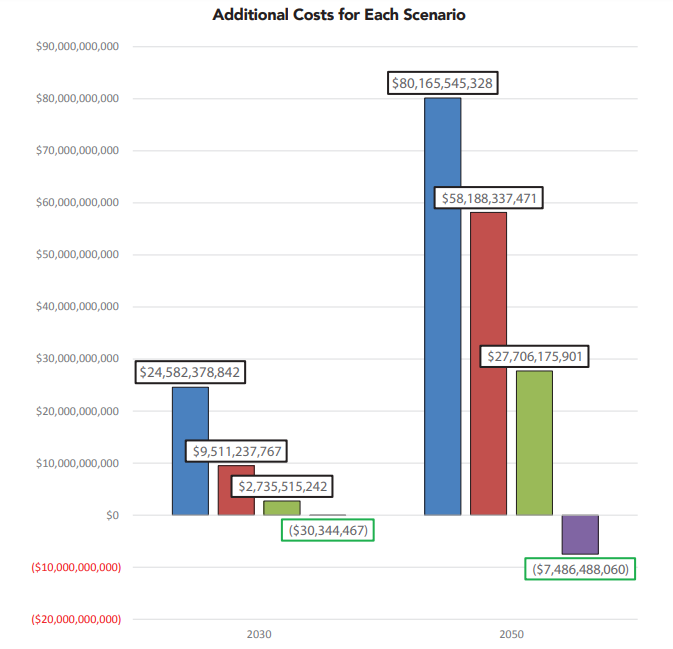
Adding carbon capture and sequestration technology as a qualifying resource is also commendable because it allows dispatchable, fossil-fuel powered resources to be utilized into the future.
While this bill represents several steps in the right direction, in its current form, it still contains provisions that will harm all Minnesotans by allowing electricity prices to continue to rise. This is of utmost importance because Minnesota electricity prices have skyrocketed since the adoption of the Next Generation Energy Act in 2007.
Historically, Minnesota had electricity prices that were 20 percent lower than the national average, but since 2005, when Xcel Energy was first required to add renewable energy to its system, Minnesota’s electricity prices have risen 27.5 percent faster than the national average, according to data from the U.S. Energy Information Administration.
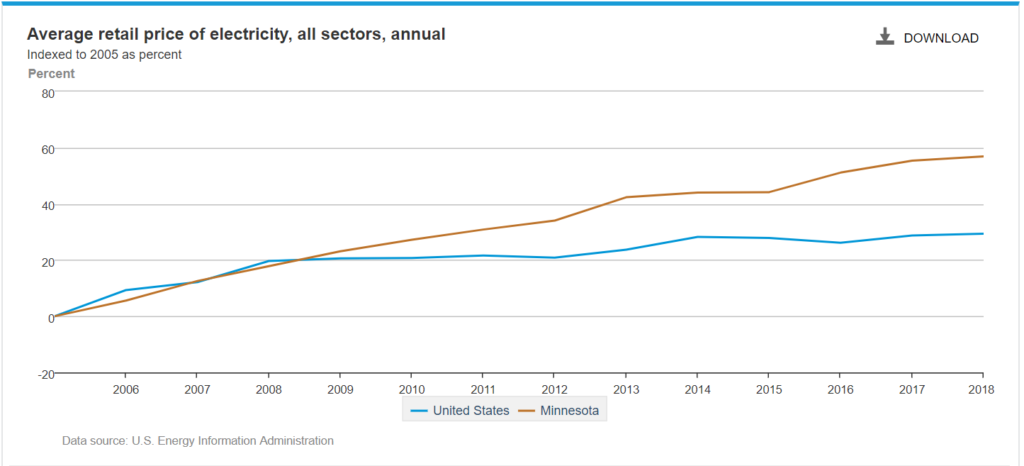
As a result of rising prices, Minnesota electric bills reached a new all-time high in 2018, and expanding Minnesota’s reliance on unreliable renewable energy sources will cause this troubling trend to continue.
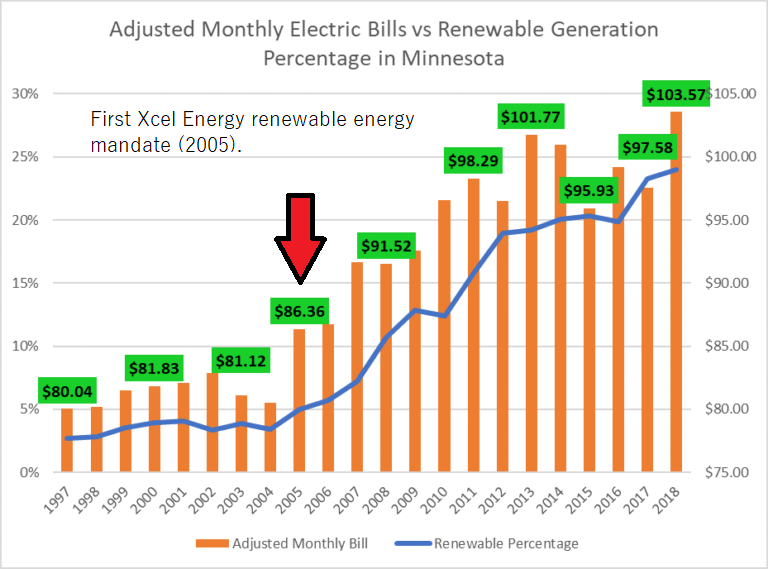
Minnesota’s rising electricity prices are largely due to the fact that our state has spent more than $15 billion on wind turbines, solar panels, and the transmission lines needed to facilitate them. Our electricity prices will soon exceed the national average.
Two provisions in this bill are problematic because they will likely result in even higher costs for consumers in the future.
One, the bill expands the authority of the Public Utilities Commission to grant cost recovery to assets that are being retired before the end of the facility’s physical life due to resource planning decisions. Two, it allows a utility retiring a carbon-emitting resources to own the replacement generation, transmission, and other facilities necessary to replace the accredited capacity and energy of the retiring facility.
While other, smaller utilities in Minnesota, such as Minnesota Power and Otter Tail Power have been responsible stewards of the public interest by keeping their electricity rates low, customers of other Investor Owned Utilities (IOUs) have suffered significant harm from utility resource planning decisions.
For example, data from the U.S. Energy Information Administration demonstrates that Xcel Energy residential customers pay far more for their electricity than customers served by other Minnesota utilities, and this disparity will only grow wider if the Public Utilities Commissions is allowed to approve cost recovery for the premature retirement of Xcel’s existing coal fleet and guarantees the utility the ability to own the replacement generation and transmission.
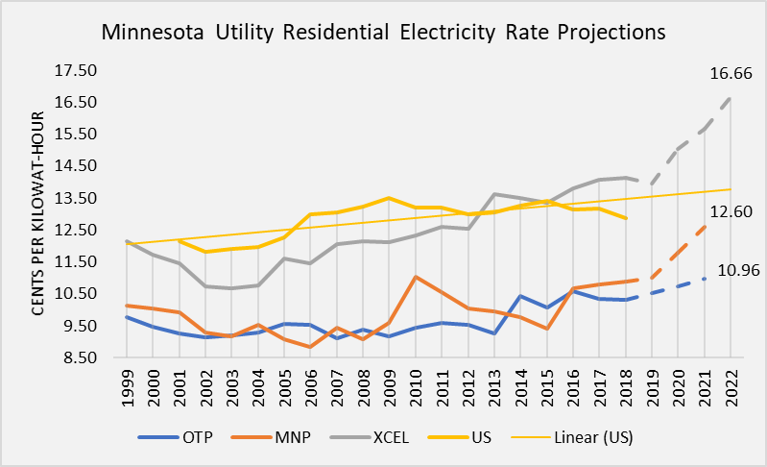
Data from the Federal Energy Regulatory Commission show Xcel’s coal fleet generates some of the lowest-cost electricity in the state. These plants generate electricity at lower cost than new, unsubsidized wind, to say nothing to the additional cost of building transmission or natural gas plants to “back up” wind turbines when the wind is not blowing.

The fact that Xcel Energy rates have increased so dramatically since 2005 demonstrates that the Public Utilities Commission has failed to protect ratepayers from predatory utility practices. Trusting the PUC with even more responsibility and power in the future seems ill advised given their recent track record.
Therefore, cost recovery of existing assets should only be granted for utilities with electricity rates below the national average. This provides a critical price signal to all utilities to keep their prices as low as possible, while still providing safe, and reliable service.
Lastly, it is important to note that if reducing carbon dioxide emissions in the primary objective of this legislation, allowing more intermittent renewables on the grid will not necessarily serve that end. EIA data show that carbon dioxide emissions increased in Minnesota in 2018, relative to 2016 and 2017.

This increase occurred despite the fact that the installed capacity of wind and solar reached a new all-time high. In fact, wind and solar installations have increased by 24 percent since 2016, but emissions increased nonetheless.
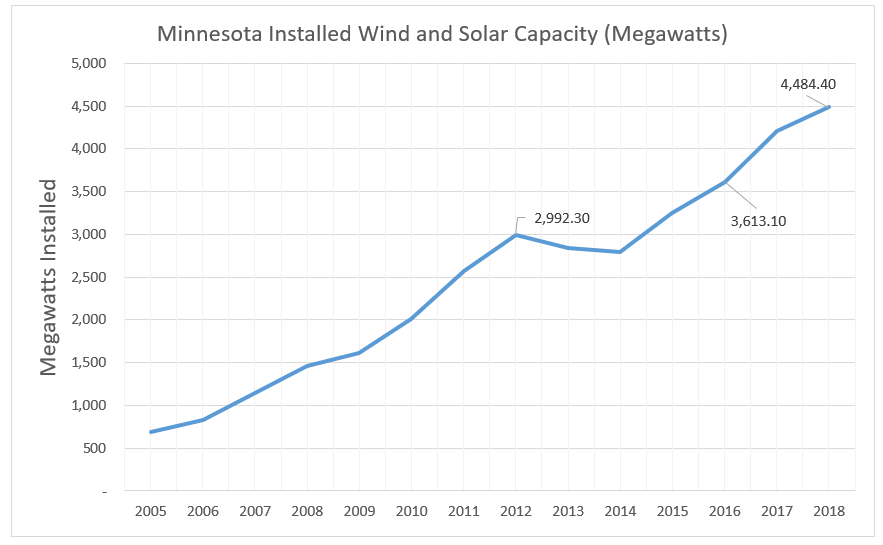
In conclusion, there is a lot of good in this bill. I do believe there can be greater emphasis on making sure the electricity prices are as low as possible for all Minnesotans while finding intelligent ways to operate in a more environmentally friendly way.
Let’s do Clean Energy Smart by keeping costs low for all Minnesotans.